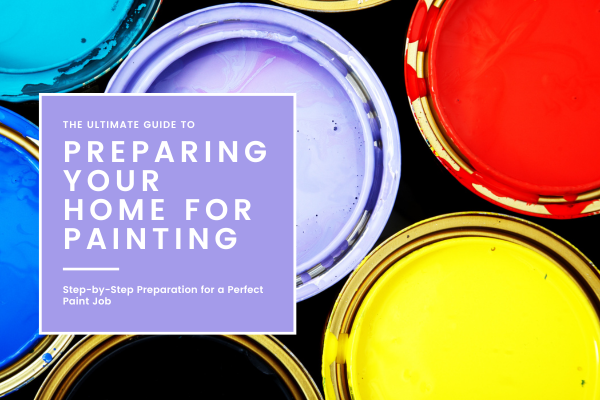
The Ultimate Guide to Preparing Your Home for Painting
“Proper preparation is the foundation of a flawless paint job. Take the time to do it right, and your home will thank you with a beautiful, lasting finish.” - Right Now Cleaning
Introduction:
Painting your home can transform its appearance and breathe new life into your living space. However, the key to a successful paint job lies in the preparation.
Proper preparation ensures a smooth, long-lasting finish and makes the painting process much easier. In this ultimate guide, we'll walk you through the essential steps to prepare different areas of your home for painting.

With that said, here are the essential steps to prepare your home for a flawless painting job! 🎨🏡
1. Gather Your Supplies
Before you start, make sure you have all the necessary supplies:
Drop cloths or plastic sheeting
Painter's tape
Sandpaper (various grits)
Scrapers and putty knives
Spackle or wood filler
Cleaning supplies (soap, water, and degreaser)
Paint brushes, rollers, and paint trays
Primer
2. Protect Your Space
Cover Furniture and Floors
Move furniture out of the room or to the center and cover with plastic sheeting or drop cloths.
Protect your floors with drop cloths or plastic sheeting, securing them with painter's tape.
Mask Off Areas
Use painter's tape to mask off areas you don’t want painted, such as baseboards, window frames, and door frames.
Be sure to press the tape down firmly to prevent paint from seeping underneath.
3. Prepare the Walls and Surfaces
Clean the Surfaces
Wipe down walls and surfaces with a damp cloth to remove dust and dirt.
Use a degreaser for kitchen walls or areas with heavy grime.
Repair Any Damage
Fill holes, cracks, and dents with spackle or wood filler.
Allow the filler to dry completely, then sand smooth with fine-grit sandpaper.
Sand the Surfaces
Lightly sand all surfaces to create a smooth, even texture.
Remove sanding dust with a vacuum or damp cloth.
4. Prime the Surfaces
Apply Primer
Use a primer to cover repaired areas and any spots with stains or discoloration.
For a uniform finish, consider priming the entire surface, especially if you’re painting over a dark color or on new drywall.
5. Prepare Trim, Doors, and Windows
Clean and Sand
Clean trim, doors, and windows thoroughly.
Sand these surfaces to ensure the paint adheres well.
Remove Hardware
Remove door handles, knobs, and any other hardware to avoid getting paint on them.
Alternatively, cover hardware with painter's tape if removal isn’t possible.
6. Special Areas Preparation
Kitchens and Bathrooms
Kitchens and bathrooms require extra attention due to moisture and grease.
Use a degreaser to clean kitchen walls and a mildew remover for bathrooms.
Sand surfaces well and use a moisture-resistant primer.
Ceilings
Clear the room as much as possible and cover the floor with drop cloths.
Clean and repair the ceiling as you would for walls.
Consider using a ceiling-specific paint that resists splatter and covers well.
7. Final Checks
Inspect Your Work
Walk around the room and inspect your preparation work.
Ensure all holes and cracks are filled, surfaces are sanded, and everything is clean.
Ensure Proper Ventilation
Open windows and use fans to ensure good ventilation while painting.
Proper ventilation helps the paint dry faster and reduces fumes.
8. Start Painting
With your home properly prepared, you're now ready to start painting. Remember, the effort you put into preparation will pay off with a professional-looking finish that lasts for years.
By following this step-by-step guide, you can confidently prepare any area of your home for painting.
For more home improvement tips and services, visit Right Now Cleaning Painting Service and let us help you achieve a flawless paint job.
Home Painting Preparation Checklist
Gather Your Supplies
Drop cloths or plastic sheeting
Painter's tape
Sandpaper (various grits)
Scrapers and putty knives
Spackle or wood filler
Cleaning supplies (soap, water, degreaser)
Paint brushes, rollers, and paint trays
Primer
Protect Your Space
Move and cover furniture with plastic sheeting or drop cloths
Cover floors with drop cloths or plastic sheeting
Mask off areas with painter's tape
Prepare the Walls and Surfaces
Clean walls and surfaces
Use degreaser for kitchen walls
Fill holes, cracks, and dents with spackle or wood filler
Sand surfaces for a smooth texture
Remove sanding dust with vacuum or damp cloth
Prime the Surfaces
Apply primer to repaired areas and stains
Consider priming entire surface for uniform finish
Prepare Trim, Doors, and Windows
Clean and sand trim, doors, and windows
Remove or cover hardware with painter's tape
Special Areas Preparation
Clean kitchen walls with degreaser
Use mildew remover for bathroom walls
Sand surfaces well
Use moisture-resistant primer in kitchens and bathrooms
Prepare ceiling as you would walls, using ceiling-specific paint
Final Checks
Inspect preparation work for completeness
Ensure proper ventilation by opening windows and using fans
With this checklist, you're well on your way to achieving a perfectly prepared home for painting.
Happy painting!


